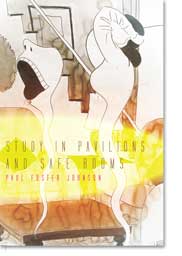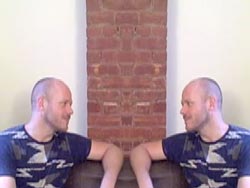Paul Foster Johnson
 I am originally from the New York metropolitan area and have lived there almost all of my life. My parents are teachers who grew up in the Bronx projects. When I was born they were committed communists, and they named me after Paul Robeson and William Z. Foster. They got me interested in politics and the arts at a young age.
I am originally from the New York metropolitan area and have lived there almost all of my life. My parents are teachers who grew up in the Bronx projects. When I was born they were committed communists, and they named me after Paul Robeson and William Z. Foster. They got me interested in politics and the arts at a young age.
I wrote tortured love poems throughout high school, but my main interest was music, and I entered college at SUNY Geneseo as a piano performance major. About halfway through, I started taking literature and writing classes and decided to change my focus. I was also active in the Youth Section of the Democratic Socialists of America, and I interned for the Prison Moratorium Project. In my senior year I was elected to student council with some of my fellow socialists, and we governed effectively. We used to make fun of people from the International Socialist Organization because they were so intense, but now I realize that I belonged in that group instead.
After college, I went for my MFA at Brown University. I learned so much from my teachers and fellow students. Providence is a quiet city, and that kept me off the streets during those most formative years. Immediately after graduation I moved to Harlem and started working in the editorial department at Routledge, the scholarly publishing house. Outside of work I curated the Experiments and Disorders reading series at Dixon Place with Sherry Mason. I started to get involved with Litmus Press and Aufgabe, which E. Tracy Grinnell had founded when we were in graduate school. These activities informed my own writing practice as I finished my first book, Refrains/Unworkings, which was ultimately published by Apostrophe Books.
Author Statement for Study in Pavilions and Safe Rooms
The first poems in this book were written after visiting the All-Russia Exhibition Center (VDNKh) on the north side of Moscow. The VDNKh is a Stalin-era exhibition center meant to showcase the triumphs of Soviet science and culture. While I was awed by the pavilions, the effects of their grandeur were undercut by historical distance (I was unimpressed by “Electrification”) and the banality of the VDNKh’s present use (shopping mall). As a repository of sublime propaganda for a totalitarian regime, this site also posed some obvious political and aesthetic problems. I wrote some poems to occupy these spaces, to imagine how a person might sense a pavilion’s exercise of power, regard it as a hieroglyph, turn away from it distractedly. I thought about the unsettled relationship between poems (monumental, ideal, outmoded) and lived experience, and tried to use the pavilions to enact this uncomfortable union. At some later point, I became interested in panic rooms commissioned by oil oligarchs and celebrities for their protection. In my desultory research, I discovered that there were DIY resources for survivalists and other paranoiacs who want to build safe rooms. I bought a how-to manual and dipped into it to achieve a crazed mindframe before writing. Like the pavilion poems, the safe room poems are not really “about” this kind of space; instead, the safe rooms are projections, hallucinations, backdrops. I wanted them to serve as a ground for exploring the mania for privacy and protection, and more general feelings of exposure or alienation or disgruntlement. The speakers are emotional, hapless nonspecialists, and the book’s structure provided me with a means of connecting personal writing with political engagement.
 Study in Pavilions and Safe Rooms
Study in Pavilions and Safe Rooms
2011, 76 pp., 6" x 9"
Poetry
$16.00 Paper, 978-0-615-43357-8
Cover illustration by Chris Warrington

